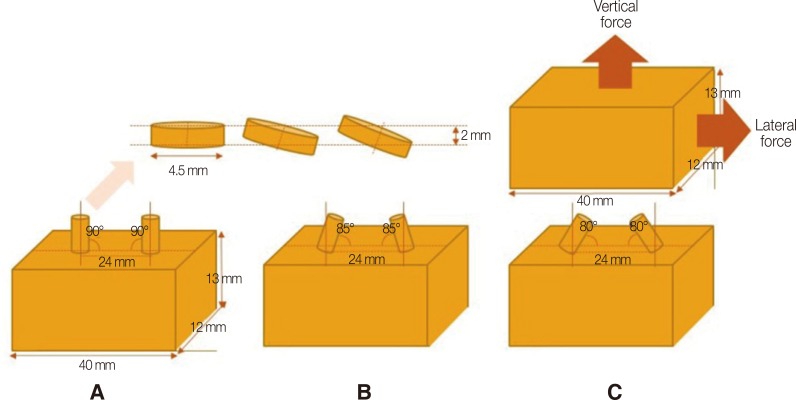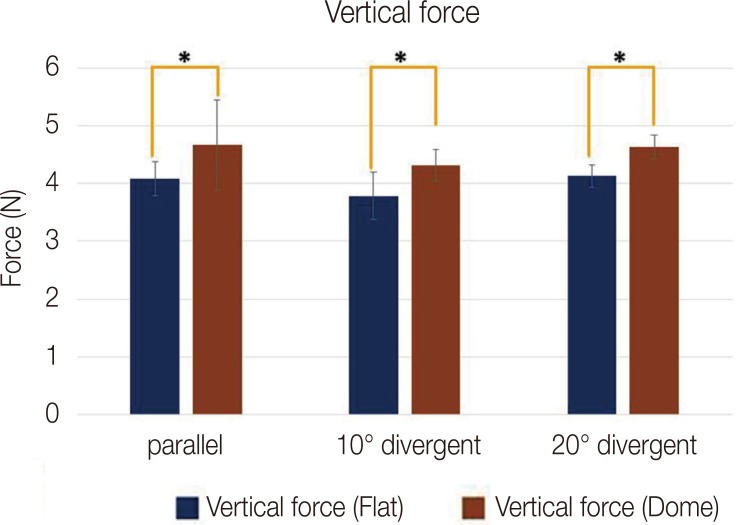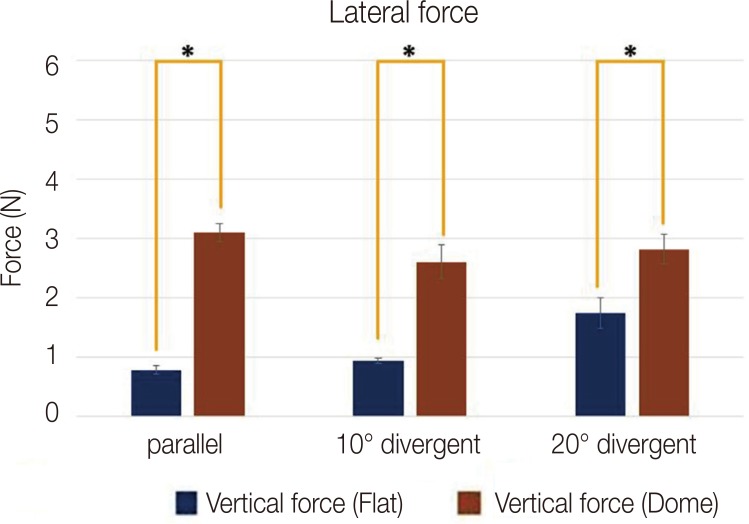J Adv Prosthodont.
2020 Feb;12(1):33-37. 10.4047/jap.2020.12.1.33.
Effects of type of magnet attachment and implant angulation in two implant overdenture models
- Affiliations
-
- 1Department of Biomedical Science, Graduate School of Korea University, Institute for Clinical Dental Research, Korea University Medical Center, Seoul, Republic of Korea.
- 2Department of Prosthodontics, Institute for Clinical Dental Research, Korea University Medical Center, Korea University, Seoul, Republic of Korea.
- 3Institute for Clinical Dental Research, Guro Hospital, Korea University Medical Center, Seoul, Republic of Korea. wddc@korea.ac.kr
- 4Institute for Clinical Dental Research, Korea University Medical Center, Seoul, Republic of Korea.
- KMID: 2470795
- DOI: http://doi.org/10.4047/jap.2020.12.1.33
Abstract
- PURPOSE
The purpose of this study is to evaluate the effects of type of magnet attachment and implant angulation in two implant overdenture models.
MATERIALS AND METHODS
Magnet attachments used in this study were flat and dome types (MGT5515, MGT5520D, Dentium Co., Seoul, Korea). Two implants with keepers were inserted in the resin blocks at a distance of 24 mm. For the first model, the implants were parallel to the vertical and perpendicular to the horizontal; for the second model, both were angulated 5 degrees to the mesial; for the third model, both were angulated 10 degrees toward the mesial. The retentive force was measured in both vertical and lateral directions. Statistical analyses were performed using SPSS software version 22.0 (α=.05).
RESULTS
The flat type magnet attachment showed the highest lateral retentive force in the 20° divergent group (P<.05) and the dome type magnet attachment showed the highest lateral retentive force in the parallel group (P<.05). The vertical and lateral retentive force of the dome type magnet attachment was greater than that of the flat type magnet attachment in every direction (P<.05).
CONCLUSION
Within the limitations of this study, the dome shape magnet attachment can resist vertical and lateral retentive force more superiorly than the flat type magnet attachment, regardless of angle, in the mandibular two implant model.
MeSH Terms
Figure
Reference
-
1. Moghadam BK, Scandrett FR. Magnetic retention for overdentures. J Prosthet Dent. 1979; 41:26–29. PMID: 364035.
Article2. Gillings BR. Magnetic retention for overdentures. Part II. J Prosthet Dent. 1983; 49:607–618. PMID: 6343587.
Article3. Feine JS, Carlsson GE, Awad MA, Chehade A, Duncan WJ, Gizani S, Head T, Lund JP, MacEntee M, Mericske-Stern R, Mojon P, Morais J, Naert I, Payne AG, Penrod J, Stoker GT Jr, Tawse-Smith A, Taylor TD, Thomason JM, Thomson WM, Wismeijer D. The McGill Consensus Statement on Overdentures. Montreal, Quebec, Canada. May 24-25, 2002. Int J Prosthodont. 2002; 15:413–414. PMID: 12170858.4. Thomason JM, Feine J, Exley C, Moynihan P, Müller F, Naert I, Ellis JS, Barclay C, Butterworth C, Scott B, Lynch C, Stewardson D, Smith P, Welfare R, Hyde P, McAndrew R, Fenlon M, Barclay S, Barker D. Mandibular two implant-supported overdentures as the first choice standard of care for edentulous patients-the York Consensus Statement. Br Dent J. 2009; 207:185–186. PMID: 19696851.5. Takeshita S, Kanazawa M, Minakuchi S. Stress analysis of mandibular two-implant overdenture with different attachment systems. Dent Mater J. 2011; 30:928–934. PMID: 22123019.
Article6. Chopra V, Smith BJ, Preiskel HW, Palmer RM, Curtis R. Breakaway forces of flat and domed surfaced Magfit implant magnet attachments. Eur J Prosthodont Restor Dent. 2007; 15:7–12. PMID: 17378452.7. Riley MA, Walmsley AD, Harris IR. Magnets in prosthetic dentistry. J Prosthet Dent. 2001; 86:137–142. PMID: 11514799.
Article8. Yang TC, Maeda Y, Gonda T, Kotecha S. Attachment systems for implant overdenture: influence of implant inclination on retentive and lateral forces. Clin Oral Implants Res. 2011; 22:1315–1319. PMID: 21426402.
Article9. Rabbani S, Juszczyk AS, Clark RK, Radford DR. Investigation of retentive force reduction and wear of the locator attachment system with different implant angulations. Int J Oral Maxillofac Implants. 2015; 30:556–563. PMID: 25671627.
Article10. Boeckler AF, Morton D, Ehring C, Setz JM. Mechanical properties of magnetic attachments for removable prostheses on teeth and implants. J Prosthodont. 2008; 17:608–615. PMID: 18761583.
Article11. Uludag B, Polat S, Sahin V, Çomut AA. Effects of implant angulations and attachment configurations on the retentive forces of locator attachment-retained overdentures. Int J Oral Maxillofac Implants. 2014; 29:1053–1057. PMID: 25216129.
Article12. ISO 13017:2012/AMD 1:2015. Dentistry - Magnetic attachments - Amendant 1. Geneva; Switzerland: International Standards Organization (ISO);2015. Accessed November, 2015. Available at: https://www.iso.org/standard/63938.html.13. Lahori M, Kaul AS, Chandra S, Nagrath R, Gupta H. Comparative evaluation of bone in mandibular implant retained overdentures using delayed and immediate loading protocol: an in-vivo study. J Indian Prosthodont Soc. 2013; 13:113–121. PMID: 24431720.
Article14. Cristache CM, Muntianu LA, Burlibasa M, Didilescu AC. Five-year clinical trial using three attachment systems for implant overdentures. Clin Oral Implants Res. 2014; 25:e171–e178. PMID: 23278517.
Article
- Full Text Links
- Actions
-
Cited
- CITED
-
- Close
- Share
- Similar articles
-
- Mandibular implant-natural tooth retained overdenture using magnetic attachment with stress breaker
- Mandibular implant overdenture using milled bar attachment on implants with unfavorable fixture angulation: A case report
- Maxillary implant-supported overdenture with magnetic attachment using healing abutment: A case report
- Mandibular implant overdenture using Locator R-Tx attachment: A case report
- The influence of the number and the type of magnetic attachment on the retention of mandibular mini implant overdenture




